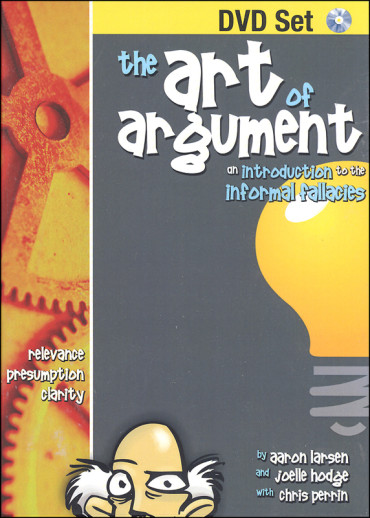We use cookies to make your experience better. To comply with the new e-Privacy directive, we need to ask for your consent to set the cookies. Learn more.
Art of Argument DVD Set
Middle and high school students will argue (and sometimes quarrel), but they won't argue well without good training. Students who complete The Art of Argument will know how to reason with clarity, relevance, and purpose . . . and have fun along the way! They will study and master 28 logical fallacies, which will provide an essential lifetime framework for filtering good and bad reasoning as well as writing and speaking effectively. This mastery of informal logic is a foundational subject by which other subjects are evaluated, assessed, and learned.
Students will enjoy using The Art of Argument 5-DVD Set as 3 experienced logic teachers and 4 capable, enthusiastic students discuss the 28 fallacies presented in The Art of Argument Student Edition. This video series is a valuable resource for every student and teacher using The Art of Argument. Each video segment (approximately 15 minutes per lesson) features one fallacy, which is presented, defined, and then discussed and explored using a blend of enthusiasm, contemplation, and humor. Each discussion seeks to make a practical application of the fallacy to student life, advertisements, political speech, or various kinds of ethical and philosophical debates.
Buying for a school? The Art of Argument video is a great tool for the classroom! It can be used as:
- a resource that will refresh and inspire the teacher
- a classroom resource for modeling and provoking discussion of the logical fallacies
- a substitute teacher when the regular teacher is away
- a resource for creating a summer school course
- a library item helpful to a struggling logic student or a curious parent
The Art of Argument video contains:
- More than 8 hours of content
- 28 videos—one for each fallacy contained in The Art of Argument text
- Fun outtakes, extras, and "logical" humor
Laced with humor and practical applications, Classical Academic Press strives to make logic accessible. And succeeds, too! The series has more background material than other logic books plus lots of "modern" examples. Making great use of dialogues and cartoons, there are some practice exercises but the emphasis is more on the "meat" of the text rather than on doing exercises. This sets them apart from other logic courses and makes them the perfect choice for students who want or need background information more than practice. This series is user-friendly and requires very little prep on the teacher's part although teacher-student interaction is necessary to maximize the learning. Art of Argument would be the starting place for a Jr. High student followed by Argument Builder and/or Discovery of Deduction, which can stand alone or be used together.
Each Student Text is designed to be worked in with the student thinking through and writing out responses to the material being presented. Teacher Editions are predominantly full-text answer keys but often include teacher's notes (a list of suggestions and recommendations for teaching the course) as well as ideas for supplementing and enriching the study. ~ Janice
Socrates is the "go to" person when it comes to fallacies (occurrence of bad or incorrect reasoning) and his perspective on the three basic categories - fallacies of irrelevance (points that don't relate to the issue), of presumption (assumptions that are not justified or necessary), and of clarity (language that confuses and muddies) - is sought via time-travel. Several examples of each are provided plus the student has the opportunity to identify fallacies in cleverly fabricated magazine advertisements. Fallacies are printed on the inside covers of the Student Text for easy reference. Both Student and TE (each about 230 pgs, pb) have appendices that include a play and a short story that illustrate fallacies as well as a Glossary and Bibliography. TE includes reproducible chapter, unit, and final exams (with answer key). DVDs include 28 sessions (one for each fallacy) in which three teachers and 4 students present, define, discuss and explain the fallacy. As in the text, the DVDs emphasize a practical application to the student's life through advertisements, political speeches, and various moral/ethical debates.
| Product Format: | DVD |
|---|---|
| Brand: | Classical Academic Press |
| Grades: | 7-12 |
| ISBN: | 9781600510632 |
| Length in Inches: | 5.25 |
| Width in Inches: | 6.5 |
| Height in Inches: | 0.75 |
| Weight in Pounds: | 0.45 |

